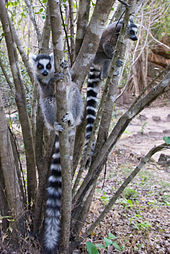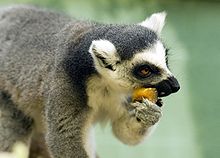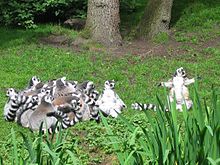
Ring-tailed lemur
(Lemur catta)

The ring-tailed lemur is a large strepsirrhine primate and the most recognized lemur due to its long, black and white ringed tail. It belongs to Lemuridae, one of five lemur families, and is the only member of the Lemur genus. Like all lemurs it is endemic to the island of Madagascar. Known locally in Malagasy as maky ([makj], spelled maki in French) or hira, it inhabits gallery forests to spiny scrub in the southern regions of the island. It is omnivorous and the most terrestrial of extant lemurs. The animal is diurnal, being active exclusively in daylight hours.
Scientific classification |
|
| Kingdom: | Animalia |
| Phylum: | Chordata |
| Class: | Mammalia |
| Order: | Primates |
| Suborder: | Strepsirrhini |
| Family: | Lemuridae |
| Genus: | Lemur |
| Specie: | Lemur catta |
Description

The ring-tailed lemur is highly social, living in groups of up to 30 individuals. It is also female dominant, a trait common among lemurs. To keep warm and reaffirm social bonds, groups will huddle together. The ring-tailed lemur will also sunbathe, sitting upright facing its underside, with its thinner white fur towards the sun. Like other lemurs, this species relies strongly on its sense of smell and marks its territory with scent glands. The males perform a unique scent marking behavior called spur marking and will participate in stink fights by impregnating their tail with their scent and wafting it at opponents.
As one of the most vocal primates, the ring-tailed lemur uses numerous vocalizations including group cohesion and alarm calls. Experiments have shown that the ring-tailed lemur, despite the lack of a large brain (relative to simiiform primates), can organize sequences, understand basic arithmetic operations and preferentially select tools based on functional qualities.
Despite reproducing readily in captivity and being the most populous lemur in zoos worldwide, numbering more than 2,000 individuals, the ring-tailed lemur is listed as endangered by the IUCN Red List due to habitat destruction and hunting for bush meat and the exotic pet trade.
Anatomy and physiology

The ring-tailed lemur is a relatively large lemur. Its average weight is 2.2 kilograms (4.9 lb). Its head-body length ranges between 39 and 46 cm (15 and 18 in), its tail length is 56 and 63 cm (22 and 25 in), and its total length is 95 and 110 cm (37 and 43 in).[3][19] Other measurements include a hind foot length of 102 and 113 mm (4.0 and 4.4 in), ear length of 40 and 48 mm (1.6 and 1.9 in), and cranium length of 78 and 88 mm (3.1 and 3.5 in).
A ring-tailed lemur runs on the ground. Its long tail trails behind it, demonstrating its length relative to the body.
The species has a slender frame and narrow face, fox-like muzzle. The ring-tailed lemur's trademark—a long, bushy tail—is ringed in alternating black and white transverse stripes, numbering 12 or 13 white rings and 13 or 14 black rings, and always ending in a black tip. The total number of rings nearly matches the approximate number of caudal vertebrae (~25). Its tail is longer than its body and is not prehensile. Instead, it is only used for balance, communication, and group cohesion.
The pelage (fur) is so dense that it can clog electric clippers. The ventral (chest) coat and throat are white or cream. The dorsal (back) coat varies from gray to rosy-brown, sometimes with a brown pygal patch around the tail region, where the fur grades to pale gray or grayish brown. The dorsal coloration is slightly darker around the neck and crown. The hair on the throat, cheeks, and ears is white or off-white and also less dense, allowing the dark skin underneath to show through. The muzzle is dark grayish and the nose is black, and the eyes are encompassed by black triangular patches. Facial vibrissae (whiskers) are developed and found above the lips (mystacal), on the cheeks (genal), and on the eyebrow (superciliary). Vibrissae are also found slightly above the wrist on the underside of the forearm. The ears are relatively large compared to other lemurs and are covered in hair, which has only small tufts if any. Although slight pattern variations in the facial region may be seen between individuals, there are no obvious differences between the sexes.
Unlike most diurnal primates, but like all strepsirhine primates, the ring-tailed lemur has a tapetum lucidum, or reflective layer behind the retina of the eye, that enhances night vision. The tapetum is highly visible in this species because the pigmentation of the ocular fundus (back surface of the eye), which is present in—but varies between—all lemurs, is very spotty. The ring-tailed lemur also has a rudimentary foveal depression on the retina. Another shared characteristic with the other strepsirrhine primates is the rhinarium, a moist, naked, glandular nose supported by the upper jaw and protruding beyond the chin. The rhinarium continues down where it divides the upper lip. The upper lip is attached to the premaxilla, preventing the lip from protruding and thus requiring the lemur to lap water rather than using suction.
The skin of the ring-tailed lemur is dark gray or black in color, even in places where the fur is white. It is exposed on the nose, palms, soles, eyelids, lips, and genitalia. The skin is smooth, but the leathery texture of the hands and feet facilitate terrestrial movement. The anus, located at the joint of the tail, is covered when the tail is lowered. The area around the anus (circumanal area) and the perineum are covered in fur. In males, the scrotum lacks fur, is covered in small, horny spines, and the two sacs of the scrotum are divided. The penis is nearly cylindrical in shape and is covered in small spines, as well as having two pairs of larger spines on both sides. Males have a relatively small baculum (penis bone) compared to their size. The scrotum, penis, and prepuce are usually coated with a foul-smelling secretion. Females have a thick, elongated clitoris that protrudes from the labia of the vulva. The opening of the urethra is closer to the clitoris than the vagina, forming a "drip tip."
Females have two pairs of mammary glands (four nipples), but only one pair is functional. The anterior pair (closest to the head) are very close to the axillae (armpit). Furless scent glands are present on both males and females. Both genders have small, dark antebrachial (forearm) glands measuring 1 cm long and located on the inner surface of the forearm nearly 25 cm (9.8 in) above the wrist joint. (This trait is shared between the Lemur and Hapalemur genera.) The gland is soft and compressible, bears fine dermal ridges (like fingerprints), and is connected to the palm by a fine, 2 mm–high, hairless strip. However, only the male has a horny spur that overlays this scent gland. The spur develops with age through the accumulation of secretions from an underlying gland that may connect through the skin through as many as a thousand minuscule ducts. The males also have brachial (arm) glands on the axillary surface of their shoulders (near the armpit). The brachial gland is larger than the antebrachial gland, covered in short hair around the periphery, and has a naked crescent-shaped orifice near the center. The gland secretes a foul-smelling, brown, sticky substance. The brachial gland is barely developed if present at all in females. Both genders also have apocrine and sebaceous glands in their genital or perianal regions, which are covered in fur.
Its fingers are slender, padded, mostly lacking webbing, and semi-dexterous with flat, human-like nails. The thumb is both short and widely separated from the other fingers. Despite being set at a right angle to the palm, the thumb is not opposable since the ball of the joint is fixed in place. As with all strepsirrhines, the hand is ectaxonic (the axis passes through the fourth digit) rather than mesaxonic (the axis passing through the third digit) as seen in monkeys and apes. The fourth digit is the longest, and only slightly longer than the second digit. Likewise, the fifth digit is only slightly longer than the second. The palms are long and leathery, and like other primates, they have dermal ridges to improve grip. The feet are semi-digitigrade and more specialized than the hands. The big toe is opposable and is smaller than the big toe of other lemurs, which are more arboreal. The second toe is short, has a small terminal pad, and has a toilet-claw (sometimes referred to as a grooming claw) specialized for personal grooming, specifically to rake through fur that is unreachable by the mouth. The toilet-claw is a trait shared among nearly all living strepsirrhine primates. Unlike other lemurs, the ring-tailed lemur's heel is not covered by fur.
Geographic range and habitat

Endemic to southern and southwestern Madagascar, the ring-tailed lemur ranges further into highland areas than other lemurs. It inhabits deciduous forests, dry scrub, montane humid forests, and gallery forests (forests along riverbanks). It strongly favors gallery forests, but such forests have now been cleared from much of Madagascar in order to create pasture for livestock. Depending on location, temperatures within its geographic range can vary from −12 °C (10 °F) at Andringitra Massif to 48 °C (118 °F) in the spiny forests of Beza Mahafaly Special Reserve.
This species is found as far east as Tôlanaro, inland towards the mountains of Andringitra on the southeastern plateau, among the spiny forests of the southern part of the island, and north along the west coast to the town of Belo sur Mer. Historically, the northern limits of its range in the west extended to the Morondava River near Morondava. It can still be found in Kirindy Mitea National Park, just south of Morondava, though at very low densities. It does not occur in Kirindy Forest Reserve, north of Morondava. Its distribution throughout the rest of its range is very spotty, with population densities varying widely.
The ring-tailed lemur can be easily seen in five national parks in Madagascar: Andohahela National Park, Andringitra National Park, Isalo National Park, Tsimanampetsotse National Park, and Zombitse-Vohibasia National Park. It can also be found in Beza-Mahafaly Special Reserve, Kalambatritra Special Reserve, Pic d'Ivohibe Special Reserve, Amboasary Sud, Berenty Private Reserve, Anja Community Reserve, and marginally at Kirindy Mitea National Park. Unprotected forests that the species has been reported in include Ankoba, Ankodida, Anjatsikolo, Anbatotsilongolongo, Mahazoarivo, Masiabiby, and Mikea.
Diet

The ring-tailed lemur is an opportunistic omnivore primarily eating fruits and leaves, particularly those of the tamarind tree (Tamarindus indica), known natively as kily. When available, tamarind makes up as much as 50% of the diet, especially during the dry, winter season. The ring-tailed lemur eats from as many as three dozen different plant species, and its diet includes flowers, herbs, bark and sap. It has been observed eating decayed wood, earth, spider webs, insect cocoons, arthropods (spiders, caterpillars, cicadas and grasshoppers) and small vertebrates (birds and chameleons). During the dry season it becomes increasingly opportunistic.
Social systems

Troops are classified as multi-male groups, with a matriline as the core group.[38] As with most lemurs, females socially dominate males in all circumstances, including feeding priority. Dominance is enforced by ] lunging, chasing, cuffing, grabbing and biting. Young females do not always inherit their mother's rank and young males leave the troop between three and five years of age.[33][38] Both sexes have separate dominance hierarchies; females have a distinct hierarchy while male rank is correlated with age. Each troop has one to three central, high-ranking adult males who interact with females more than other group males and lead the troop procession with high-ranking females. Recently transferred males, old males or young adult males that have not yet left their natal group are often lower ranking. Staying at the periphery of the group they tend to be marginalized from group activity.
A group of three ring-tailed lemurs rest in the sun, with two sitting upright, facing the sun, with their arms to their sides.
For males, social structure changes can be seasonal. During the six-month period between December and May a few males immigrate between groups. Established males transfer on average every 3.5 years, although young males may transfer approximately every 1.4 years. Group fission occurs when groups get too large and resources become scarce.
In the mornings the ring-tailed lemur sunbathes to warm itself. It faces the sun sitting in what is frequently described as a "sun-worshipping" posture or lotus position. However, it sits with its legs extended outward, not cross-legged, and will often support itself on nearby branches. Sunning is often a group activity, particularly during the cold mornings. At night, troops will split into sleeping parties huddling closely together to keep warm.
Despite being quadrupedal the ring-tailed lemur can rear up and balance on its hind legs, usually for aggressive displays. When threatened the ring-tailed lemur may jump in the air and strike out with its short nails and sharp upper canine teeth in a behaviour termed jump fighting. This is extremely rare outside of the breeding season when tensions are high and competition for mates is intense. Other aggressive behaviours include a threat-stare, used to intimidate or start a fight, and a submissive gesture known as pulled-back lips.
Border disputes with rival troops occur occasionally and it is the dominant female's responsibility to defend the troop's home range. Agonistic encounters include staring, lunging approaches and occasional physical aggression, and conclude with troop members retreating toward the center of the home range.
Olfactory communication
Olfactory communication is critically important for strepsirrhines like the ring-tailed lemur. Males and females scent mark both vertical and horizontal surfaces at the overlaps in their home ranges using their anogenital scent glands. The ring-tailed lemur will perform a handstand to mark vertical surfaces, grasping the highest point with its feet while it applies its scent.[38] Use of scent marking varies by age, sex and social status.[39] Male lemurs use their antebrachial and brachial glands to demarcate territories and maintain intragroup dominance hierarchies. The thorny spur that overlays the antebrachial gland on each wrist is scraped against tree trunks to create grooves anointed with their scent. This is known as spur-marking.In displays of aggression, males engage in a social display behaviour called stink fighting, which involves impregnating their tails with secretions from the antebrachial and brachial glands and waving the scented tail at male rivals.
Ring-tailed lemurs have also been shown to mark using urine. Behaviorally, there is a difference between regular urination, where the tail is slightly raised and a stream of urine is produced, and the urine marking behavior, where the tail is held up in display and only a few drops of urine are used. The urine-marking behavior is typically used by females to mark territory, and has been observed primarily at the edges of the troop's territory and in areas where other troops may frequent. The urine marking behavior also is most frequent during the mating season, and may play a role in reproductive communication between groups
Auditory communication
The ring-tailed lemur is one of the most vocal primates and has a complex array of distinct vocalizations used to maintain group cohesion during foraging and alert group members to the presence of a predator. Calls range from simple to complex. An example of a simple call is the purr, which expresses contentment. A complex call is the sequence of clicks, close-mouth click series (CMCS), open-mouth click series (OMCS) and yaps used during predator mobbing. Some calls have variants and undergo transitions between variants, such as an infant "whit" (distress call) transitioning from one variant to another.The most commonly heard vocalizations are the moan (low-to-moderate arousal, group cohesion), early-high wail (moderate-to-high arousal, group cohesion), and clicks ("location marker" to draw attention).
Breeding and reproduction
The ring-tailed lemur is polygynandrous, although the dominant male in the troop typically breeds with more females than other males. Fighting is most common during the breeding season. A receptive female may initiate mating by presenting her backside, lifting her tail and looking at the desired male over her shoulder. Males may inspect the female's genitals to determine receptiveness. Females typically mate within their troop, but may seek outside males.The breeding season runs from mid-April to mid-May. Estrus lasts 4 to 6 hours, and females mate with multiple males during this period. Within a troop, females stagger their receptivity so that each female comes into season on a different day during the breeding season, reducing competition for male attention. Gestation lasts for about 135 days, and parturition occurs in September or occasionally October. In the wild, one offspring is the norm, although twins may occur. Ring-tailed lemur infants have a birth weight of 70 g (2.5 oz) and are carried ventrally (on the chest) for the first 1 to 2 weeks, then dorsally (on the back).
The young lemurs begin to eat solid food after two months and are fully weaned after five months. Sexual maturity is reached between 2.5 and 3 years. Male involvement in infant rearing is limited, although the entire troop, regardless of age or sex, can be seen caring for the young. Alloparenting between troop 4 females has been reported. Kidnapping by females and infanticide by males also occur occasionally. Due to harsh environmental conditions, predation and accidents such as falls, infant mortality can be as high as 50% within the first year and as few as 30% may reach adulthood. The longest-lived ring-tailed lemur in the wild was a female at the Berenty Reserve who lived for 20 years. In the wild, females rarely live past the age of 16, whereas the life expectancy of males is not known due to their social structure. The longest-lived male was reported to be 15 years old. The maximum lifespan reported in captivity was 27 years.
Conservation status
Endangered
Zoológico de Vallarta A. C.
Leave your comments, your opinion is important to us

